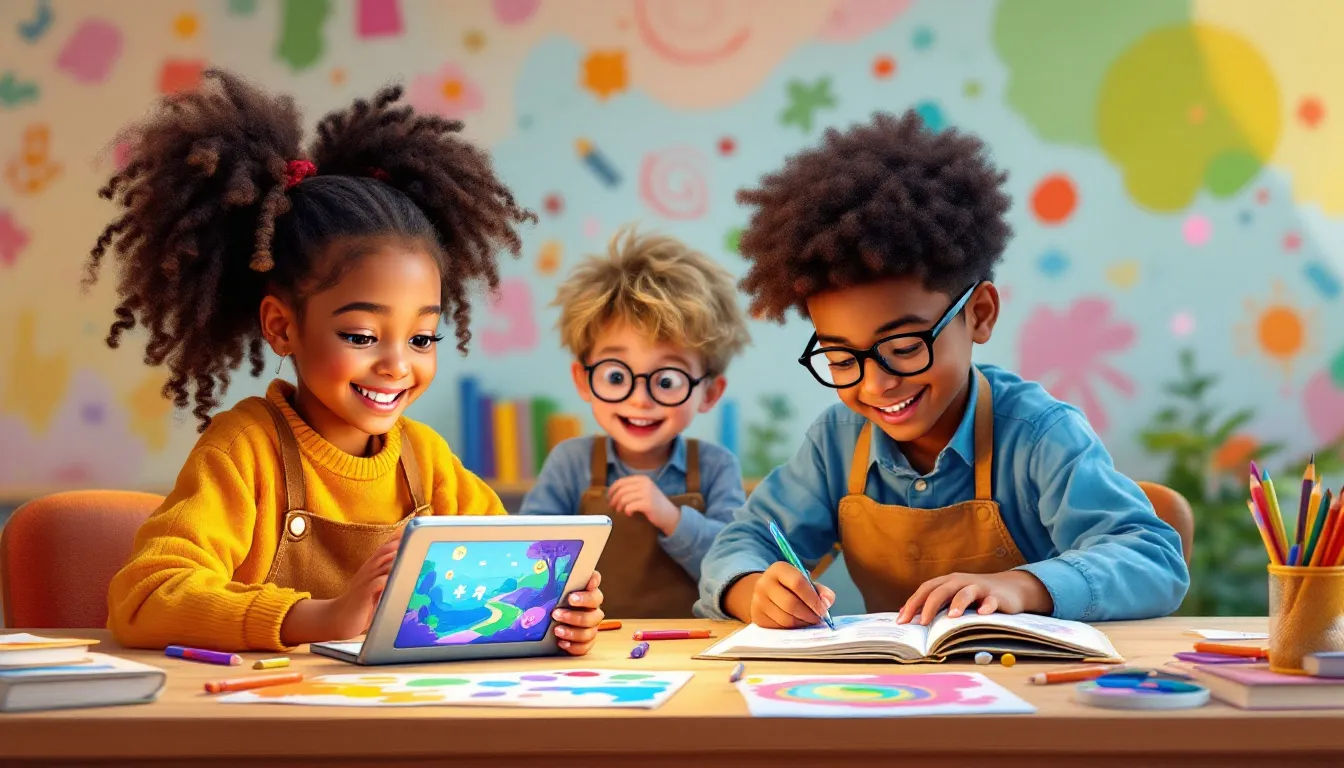Creating an inclusive classroom environment is crucial, yet teachers often lack the resources to build a curriculum that represents diverse cultures and perspectives.
This article provides teachers with the top cultural resources for developing a comprehensive, responsive curriculum that fosters equity, diversity and inclusion.
You'll discover specific frameworks, checklists and standards for auditing and enhancing your curriculum, along with an array of multimedia tools showcasing global cultures. Implementing these best practices will help cultivate a welcoming, multicultural school community where all students feel valued and empowered.
Introduction to Inclusive Education
An inclusive curriculum embraces diverse perspectives and promotes critical thinking. By integrating cultural resources into lesson plans, teachers can create a welcoming environment where all students see themselves represented.
Understanding the Role of Cultural Resources in Education
Cultural resources like books, films, art, and websites expose students to new ideas and experiences. When selecting materials, it's important to choose ones that authentically portray underrepresented groups. Resources should empower students to think critically about their own cultures and those of their classmates.
Teachers can use cultural resources to facilitate challenging conversations about diversity, equity, and inclusion. With thoughtful discussion questions and activities, students can gain intercultural understanding and civic awareness. Educators should provide context to help students analyze resources through various cultural lenses.
The Importance of Diversity, Equity, and Inclusion in K-12 Education
Research confirms that inclusive curriculums have academic and social-emotional benefits. Seeing role models from diverse backgrounds improves outcomes for minority students. Discussing different cultural perspectives develops critical thinking abilities for all.
An inclusive climate also promotes civic values like tolerance and respect. Appreciating diversity prepares students to collaborate across differences in college, career, and community life. By normalizing conversations about equity, schools can identify and address systemic barriers facing disadvantaged groups.
With comprehensive teacher training and culturally responsive materials, schools can ensure no student feels marginalized. Building an inclusive curriculum requires ongoing work, but the long-term impacts make it well worth the effort.
How do you make a culturally inclusive lesson?
Creating a culturally inclusive classroom begins with getting to know your students and their families. Learn about their backgrounds, values, traditions, and perspectives. Design lessons and activities that validate and reflect student identities.
When building your curriculum and selecting classroom materials:
- Include perspectives from diverse cultures, ethnicities, races, religions, genders, sexual orientations, abilities, etc.
- Select texts and authors that represent the diversity of your students.
- Use examples and case studies relevant to your students' communities.
Account for different languages and communication styles in your teaching:
- Allow students to express ideas in their native languages.
- Speak clearly and check frequently for understanding.
- Be patient with non-native or multilingual speakers.
Have consistently high expectations for all students regardless of background. Empower them to share ideas, participate fully, and take ownership of their learning.
Continually evaluate your own biases and how they may unconsciously impact your teaching. Seek out resources and training for developing cultural competence. Building an inclusive classroom is an ongoing process of self-reflection, adaptation, and growth for both you and your students.
How can educators create a culturally inclusive environment?
Creating a culturally inclusive classroom environment is essential for supporting diverse students and nurturing a sense of belonging. Here are some practical tips educators can implement:
Use diverse cultural representations in curriculum and visuals
- Integrate authors, historical figures, scientists, artists, and other role models from a wide range of cultural backgrounds into lesson content.
- Display posters, artwork, decorations, and reading materials representing various cultures.
Encourage identity sharing and perspective-taking
- Have students share stories of their family backgrounds and cultural traditions.
- Facilitate discussions allowing students to exchange perspectives and increase mutual understanding.
Review classroom resources for bias
- Audit textbooks, novels, and other materials for stereotypical depictions, exclusionary language, or lack of diversity.
- Seek out resources created by authors with multicultural backgrounds and experiences.
Foster an environment for respectful dialogue
- Establish clear guidelines for civil discourse that maintains psychological safety.
- Moderate challenging conversations with compassion and nuance.
Pursue continuous learning as an educator
- Attend cultural competency trainings to expand awareness of implicit bias and microaggressions.
- Stay updated on best practices for equity, inclusion and culturally sustaining pedagogies.
Creating an inclusive environment requires ongoing reflection, dialogue, and growth for both students and teachers. But the rewards of increased belonging, identity affirmation and cross-cultural bonds make it profoundly worthwhile.
What is a culturally inclusive curriculum?
A culturally inclusive curriculum incorporates materials and perspectives from diverse cultures, backgrounds, and identities. The goal is to create a learning environment where all students feel represented, valued, and empowered.
Here are some key elements of a culturally inclusive curriculum:
- Materials that reflect the diversity of the student population - featuring authors, historical figures, scientists, artists, etc. from a range of cultural backgrounds.
- Content that explores issues of identity, diversity, equity and inclusion. This allows students to develop cultural awareness and empathy.
- Multiple cultural perspectives integrated into lessons across subject areas - not just designated multicultural units.
- Scaffolding to support English Language Learners. This includes visuals, translations, clear instructions, building background knowledge.
- Culturally responsive teaching strategies, like cooperative learning, inquiry-based learning and community involvement.
An inclusive curriculum requires ongoing self-reflection from educators to identify and mitigate bias. It also requires flexibility to adapt materials and instruction to the needs of the specific community. When done effectively, it can create a positive classroom culture where all students thrive.
How do you develop a culturally responsive curriculum?
Developing a culturally responsive curriculum requires educators to:
Know Your Students
Get to know your students' backgrounds, cultures, languages, families, interests, and more. Build strong relationships and see your students' strengths.
Examine Personal Biases
Reflect on your own biases and how they impact your teaching. Seek out professional development on culturally responsive teaching.
Transform Pedagogy
Adapt your teaching methods to be more inclusive of diverse cultures and perspectives represented in your classroom.
Respect Student Culture
Incorporate students' cultural backgrounds into the curriculum. Validate and affirm students' cultures to reinforce pride and engagement.
Involve Family & Community
Invite families and communities to share their perspectives. Solicit their input when designing curriculum and activities.
sbb-itb-bb2be89
Creating a Culturally Responsive Curriculum Framework
Teachers can utilize the following step-by-step framework to audit, evaluate, and enhance their curriculum with culturally responsive resources:
Utilizing a DEI Curriculum Checklist for Comprehensive Audits
- Review curriculum materials, books, articles, videos, projects, and assessments through the lens of diversity, equity and inclusion
- Analyze representation of different cultures, perspectives, identities across subjects
- Evaluate cultural relevance and sensitivity of topics, examples, language used
- Use checklists from Teaching Tolerance, Learning for Justice to benchmark materials
- Identify gaps and areas needing improvement
Identifying and Addressing Cultural Gaps
- Pinpoint subjects, units, materials lacking representation or cultural relevance
- Gather feedback from students, parents, community on curriculum inclusiveness
- Prioritize high impact gaps to address first
- Develop goals and timeline for enhancing curriculum
Incorporating Diverse and Inclusive Resources
- Curate articles, books, media on underrepresented groups and perspectives
- Integrate lesson plans from #BlackLivesMatter, Learning for Justice, Smithsonian
- Feature writings, videos, projects giving voice to minority narratives
- Select resources showcasing positive representations of diversity
- Ensure new materials align to cultural competence standards
This framework of auditing, evaluating and upgrading curriculum resources through a diversity, equity and inclusion lens can help teachers build more representative and culturally responsive learning environments.
Cultivating a Multicultural School Community with Top Cultural Resources
These trusted organizations and platforms offer high-quality materials for building multicultural lesson plans, projects and curriculum.
Adopting Learning for Justice's Social Justice Standards
Learning for Justice provides a comprehensive framework and resources for integrating themes of diversity, justice and action across K-12 curriculum. Their Social Justice Standards establish guidance and lesson plans across four domains: Identity, Diversity, Justice and Action.
Teachers can use these standards to audit existing curriculum and develop new multicultural lesson plans. The standards help educators foster positive social identities, understand diverse cultures and perspectives, recognize inequality and injustice, and cultivate student agency to promote positive change.
Resources include grade-specific lesson plans on topics like examining personal and social identities, understanding diverse family structures, analyzing media representations, exploring the legacy of racist policies and practices, and taking informed action on issues students care about.
Teaching Tolerance: Perspectives for Multicultural Classrooms
Teaching Tolerance offers a vast collection of free K-12 lessons and resources for building cultural competency and promoting justice in education. Their Perspectives for a Diverse America curriculum helps students explore identity, diversity, justice and action through the lenses of various cultural groups.
Units provide interactive lesson plans, readings, videos and activities to foster intercultural understanding and confront bias. Topics range from Native American histories and Latinx immigration experiences to the evolution of LGBTQ rights and the disability rights movement.
The lessons promote cultural literacy, critical thinking, and ethical citizenship by immersing students in diverse perspectives. Teachers can mix and match materials to build customized units tailored to their classroom demographics and needs.
Exploring Global Cultures with Google Arts & Culture
Google Arts & Culture features free online exhibits and activities drawing from over 2000 leading museums and archives worldwide. Teachers can access virtual tours, high-resolution images, expert essays and interactive elements to enhance multicultural curriculum.
Exhibits like "We Wear Culture" showcase global textile traditions, while "Once Upon a Try" uses storytelling to explore inventions across cultures. "Women Who Changed Art Forever" profiles diverse female artists who broke barriers. Lesson plans, classroom activities and collections like "Cultural Institutions in Crisis" help students grapple with cultural preservation.
By tapping into Google's expansive digital archive, educators gain engaging materials for comparing global cultures, discussing representation in art, examining social change movements and more.
Learning from The National Museum of African American History and Culture
This Smithsonian museum offers a wealth of online educational resources for teaching African American histories and culture. Their expansive collections provide primary sources, images, oral histories and artifacts for developing responsive curriculum.
Lesson plans like "Slavery from Historical and Contemporary Perspectives" integrate meaningful discussion of difficult histories. Activities like "Exploring African American Family Histories" help students make personal connections. And exhibits like "Taking the Stage" chronicle Black musical innovations through interactive timelines.
Educators can tap into these rich, authoritative materials to foster more holistic understandings of African American experiences and contributions across history. Integrating such narratives helps build a more inclusive curriculum reflecting our diverse national identity.
Implementing Culturally Responsive Teaching Strategies
Teachers can promote equity and inclusion in their classrooms through various culturally responsive teaching strategies. Here are some methods to make daily instruction more inclusive:
Enhancing Equity for English-Language Learners
- Curate classroom book collections featuring authors and characters with diverse cultural backgrounds that English Language Learners can relate to.
- Provide visual aids, gestures, and other scaffolds to support comprehension.
- Allow students to demonstrate understanding in multiple modalities like writing, speaking, drawing.
Facilitating Challenging Conversations and Civil Discourse
- Lead structured small-group dialogues for students to share perspectives on their cultural identities and life experiences.
- Teach skills for respectful discussion like listening, asking questions, and disagreeing constructively.
- Intervene appropriately if conversations become uncivil; refocus on mutual understanding.
Showcasing Diverse Role Models in Every Subject
- Integrate case studies, profiles, and projects highlighting diversity within each field of study.
- Counter stereotypes by featuring underrepresented groups' contributions to different disciplines.
- Have students research and present on admirable figures from a variety of cultural backgrounds.
Designing Social Justice Projects for Civic Engagement
- Develop experiential projects for students to engage with social justice issues like inequality, discrimination.
- Provide platforms for students to apply subject knowledge to real-world problems affecting their communities.
- Encourage civic action like writing to representatives or organizing community service initiatives.
Implementing small but consistent changes like diversifying curricula, facilitating constructive dialogue, and providing service opportunities can make classrooms more equitable and culturally responsive over time. The strategies above aim to promote inclusion while developing students' intercultural literacy.
Evaluating the Impact of a Culturally Responsive Curriculum
Setting Inclusive Benchmarks and Measuring Progress
Defining quantitative inclusion targets and measuring progress is key to ensuring curriculum enhancements translate to real-world impact. Consider setting goals for diverse representation across subject areas, resource types, and learning activities. Track metrics over time to gauge progress and inform further improvements.
For example, aim for a minimum of 25% of literature selections and historical references to represent non-white, non-male perspectives. Or target at least 1 culturally-inclusive activity per week in each subject. Regularly pull data to see where gaps exist.
Gathering Student Feedback on Inclusivity and Belonging
Solicit anonymous student feedback through surveys and focus groups to understand perceptions around cultural representation and engagement. Ask questions like:
- Do you feel your identity and experiences are valued in the curriculum?
- How well does our school embrace diverse perspectives?
- What changes would make you feel more included?
Look for trends and actionable suggestions. Be prepared to address difficult topics with empathy.
Assessing Students' Cultural Competency Development
Assess students' abilities to respectfully discuss complex issues, appreciate multiple viewpoints, and interact positively across cultures. Methods could include:
- Student presentations analyzing an issue from diverse lenses
- Facilitated small group dialogues on challenging topics
- Reflective writing assignments on their cultural assumptions
Set rubrics benchmarking competency development. Progress demonstrates the curriculum’s efficacy in building understanding.
Conclusion: Committing to a Continuously Evolving Inclusive Curriculum
Building an inclusive curriculum requires an ongoing commitment to enhancing lessons and resources with diverse perspectives. Here are some final tips for teachers looking to foster equity in their classrooms:
Continuously Evaluate and Update Materials
- Audit existing curriculum and texts for biases or lack of representation
- Seek out resources and narratives from historically excluded groups
- Replace outdated or insensitive materials with more inclusive options
Make Diversity and Inclusion an Ongoing Process
- Set aside time each term to find new texts, case studies, and activities
- Attend trainings and workshops on topics like culturally sustaining pedagogy
- Engage students and families in providing input and feedback
Collaborate with Other Educators
- Share best practices on diversifying curriculum with colleagues
- Co-develop interdisciplinary units that incorporate diverse narratives
- Partner with community organizations to bring new perspectives into the classroom
Committing to an inclusive curriculum requires dedicated time and effort to evaluating, enhancing, and expanding teaching materials and activities. By making diversity and representation an ongoing process - rather than a one-time initiative - schools and teachers can foster more equitable and culturally sustaining learning environments.


